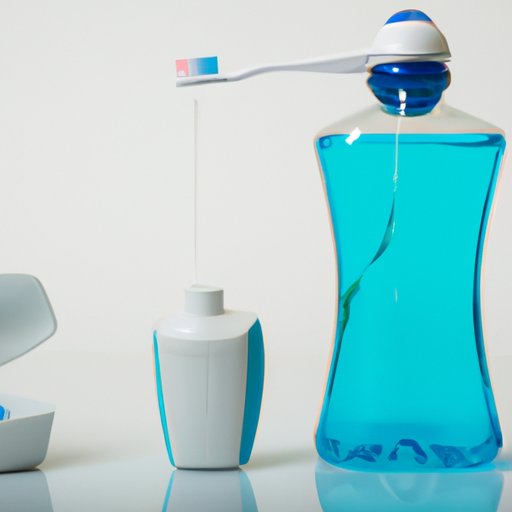Introduction
Good dental health is an important part of overall well-being. Without proper care, the teeth and gums can be susceptible to decay, infection, and other serious problems. Fortunately, there are easy steps that can be taken to ensure that your teeth and gums stay healthy. In this article, we’ll explore how to take care of teeth and gums at home.

Brush Twice a Day with Fluoride Toothpaste
The most basic step in taking care of your teeth and gums is to brush twice a day with fluoride toothpaste. Brushing with fluoride toothpaste helps remove plaque, a sticky film that builds up on teeth, and food particles that can cause cavities and gum disease. Fluoride also helps strengthen tooth enamel, making it more resistant to decay.
When brushing, be sure to use a soft-bristled toothbrush and a pea-sized amount of toothpaste. Use gentle circular motions to reach all surfaces of the teeth and gums. Be sure to brush for two minutes, paying special attention to the back molars. After brushing, rinse your mouth with water or an antimicrobial mouthwash.

Floss Daily to Remove Plaque and Food Particles
In addition to brushing, it’s important to floss daily to remove plaque and food particles that can’t be reached by a toothbrush. Flossing helps prevent cavities and gum disease by removing plaque and food particles that can lead to decay. Flossing also helps keep your breath fresh.
When flossing, use a piece of floss that is 18 inches long and wrap the ends around your middle fingers. Gently insert the floss between each tooth and move it up and down in a “C” shape. Be sure to floss behind the back molars, as these areas are often missed. After flossing, rinse your mouth with water or an antimicrobial mouthwash.
Use an Antimicrobial Mouthwash Regularly
Using an antimicrobial mouthwash regularly can help reduce plaque and prevent tooth decay and gum disease. It also helps freshen breath and keep the mouth moist. When choosing a mouthwash, look for one that contains fluoride and cetylpyridinium chloride, an ingredient that helps reduce plaque.
When using mouthwash, swish it around the mouth for 30 seconds before spitting it out. Don’t swallow the mouthwash, as it contains ingredients that can be harmful if ingested. After rinsing, wait at least 30 minutes before eating or drinking anything.

Eat a Balanced Diet and Avoid Sugary Snacks
Eating a balanced diet is another important step in taking care of your teeth and gums. Eating plenty of fruits, vegetables, and whole grains helps provide the vitamins and minerals needed for good dental health. Avoiding sugary snacks and drinks is also important, as sugar can cause tooth decay.
If you do eat sugary snacks, be sure to brush and floss afterwards. Additionally, try to drink plenty of water throughout the day, as it helps wash away food particles and bacteria.
Visit the Dentist Every Six Months for a Checkup and Cleaning
Visiting the dentist every six months for a checkup and cleaning is an important part of maintaining good dental health. During a checkup, the dentist will examine your teeth and gums for signs of decay, infection, and other problems. The dentist will also clean your teeth, removing plaque and tartar buildup that can cause cavities and gum disease.
When choosing a dentist, be sure to find one who is experienced and has a good reputation. Ask friends and family for recommendations, and read online reviews to get an idea of what other patients think about the dentist. Also, be sure to ask about costs and insurance coverage.
Consider Using a Water Flosser to Reach Hard-to-Clean Areas
For those who have difficulty flossing, a water flosser can be a great alternative. Water flossers use a stream of pulsating water to reach hard-to-clean areas between the teeth and gums. They are especially beneficial for people with braces or bridges, as they can help remove food particles and plaque from hard-to-reach areas.
When using a water flosser, start by filling the reservoir with water and adding any mouthwash or other solutions if desired. Then, place the tip of the flosser against the gum line and slowly move it up and down. Be sure to floss all surfaces of the teeth and gums, including the back molars. After flossing, rinse your mouth with water or an antimicrobial mouthwash.
Conclusion
Taking care of your teeth and gums at home is essential for maintaining good dental health. Be sure to brush twice a day with fluoride toothpaste, floss daily, use an antimicrobial mouthwash regularly, eat a balanced diet, and visit the dentist every six months for a checkup and cleaning. For those with difficulty flossing, consider using a water flosser to help reach hard-to-clean areas. By following these tips, you can help keep your teeth and gums healthy and strong.
(Note: Is this article not meeting your expectations? Do you have knowledge or insights to share? Unlock new opportunities and expand your reach by joining our authors team. Click Registration to join us and share your expertise with our readers.)
